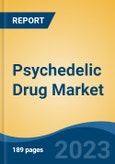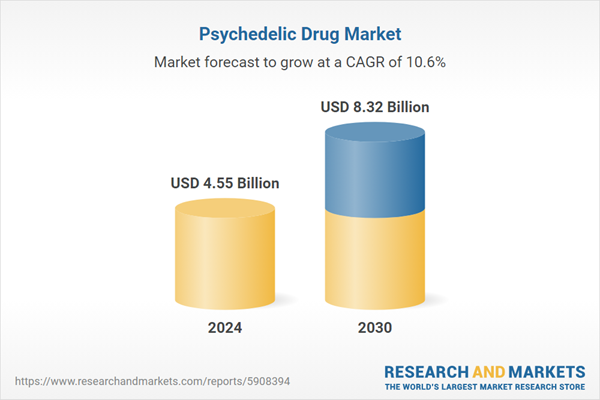Speak directly to the analyst to clarify any post sales queries you may have.
10% Free customizationThis report comes with 10% free customization, enabling you to add data that meets your specific business needs.
Market growth is being further catalyzed by increasing mental health awareness, progressive policy reforms, and a growing body of scientific evidence supporting the medical utility of psychedelics. Strategic partnerships between pharmaceutical companies, biotech firms, and research institutions are accelerating drug development pipelines, positioning psychedelic compounds for potential mainstream integration within psychiatric care. As regulatory approvals expand and investment in research and development intensifies, the psychedelic drug market is poised for substantial long-term growth.
Key Market Drivers
Rising Prevalence of Mental Health Disorders
The increasing global prevalence of mental health disorders is one of the most significant catalysts driving the growth of the psychedelic drugs market. As traditional treatment approaches struggle to meet the rising demand for effective solutions, psychedelic-assisted therapies are emerging as a disruptive innovation in psychiatric care. The burden of mental health disorders has reached unprecedented levels, with conditions such as depression, anxiety, and post-traumatic stress disorder (PTSD) affecting millions worldwide. According to data from the World Health Organization (WHO), depression affects more than 284 million individuals worldwide, making it one of the most widespread mental health conditions.Similarly, over 264 million people are impacted by anxiety disorders, highlighting the growing demand for effective mental health interventions. Despite these alarming statistics, conventional treatments - including selective serotonin reuptake inhibitors (SSRIs) and cognitive-behavioral therapy (CBT) - often produce suboptimal results, with many patients experiencing delayed symptom relief, treatment resistance, or severe side effects. This growing treatment gap has created a strong demand for innovative therapies, positioning psychedelics as a viable alternative.
Key Market Challenges
Regulatory Hurdles
Perhaps the most significant challenge facing the psychedelic drug market is the complex and evolving regulatory landscape. Many psychedelics are classified as controlled substances due to their historical association with recreational use and concerns about safety and abuse potential. Navigating these regulations can be a lengthy and expensive process, often requiring years of clinical trials and regulatory approvals.Key Market Players
- Jazz Pharmaceuticals PLC
- NeonMind Biosciences Inc.
- Cybin Inc.
- Pfizer Inc
- Numinus Wellness Inc
- Mind Medicine Inc
- PharmaTher Holdings Ltd
- NRX Pharmaceuticals Inc
- Seelos Therapeutics Inc
- Revive Therapeutics Inc
Report Scope:
In this report, the Global Psychedelic Drug Market has been segmented into the following categories, in addition to the industry trends which have also been detailed below:Psychedelic Drug Market, By Drug Type:
- Lysergic Acid Diethylamide
- Gamma Hydroxybutyric Acid
- Ketamine
- Psilocybin
- Others
Psychedelic Drug Market, By Application:
- Treatment-Resistant Depression
- Opiate Addiction
- Post-Traumatic Stress Disorder
- Narcolepsy
- Panic Disorders
- Others
Psychedelic Drug Market, By Distribution Channel:
- Hospital Pharmacies
- Retail Pharmacies
- Online Pharmacies
Psychedelic Drug Market, By Region:
- North America
- United States
- Canada
- Mexico
- Europe
- Germany
- United Kingdom
- France
- Italy
- Spain
- Asia-Pacific
- China
- Japan
- India
- Australia
- South Korea
- South America
- Brazil
- Argentina
- Colombia
- Middle East & Africa
- South Africa
- Saudi Arabia
- UAE
Competitive Landscape
Company Profiles: Detailed analysis of the major companies present in the Global Psychedelic Drug Market.Available Customizations:
With the given market data, the publisher offers customizations according to a company's specific needs. The following customization options are available for the report.Company Information
- Detailed analysis and profiling of additional market players (up to five).
This product will be delivered within 1-3 business days.
Table of Contents
Companies Mentioned
- Jazz Pharmaceuticals PLC
- NeonMind Biosciences Inc.
- Cybin Inc.
- Pfizer Inc
- Numinus Wellness Inc
- Mind Medicine Inc
- PharmaTher Holdings Ltd
- NRX Pharmaceuticals Inc
- Seelos Therapeutics Inc
- Revive Therapeutics Inc
Table Information
| Report Attribute | Details |
|---|---|
| No. of Pages | 186 |
| Published | March 2025 |
| Forecast Period | 2024 - 2030 |
| Estimated Market Value ( USD | $ 4.55 Billion |
| Forecasted Market Value ( USD | $ 8.32 Billion |
| Compound Annual Growth Rate | 10.5% |
| Regions Covered | Global |
| No. of Companies Mentioned | 10 |









